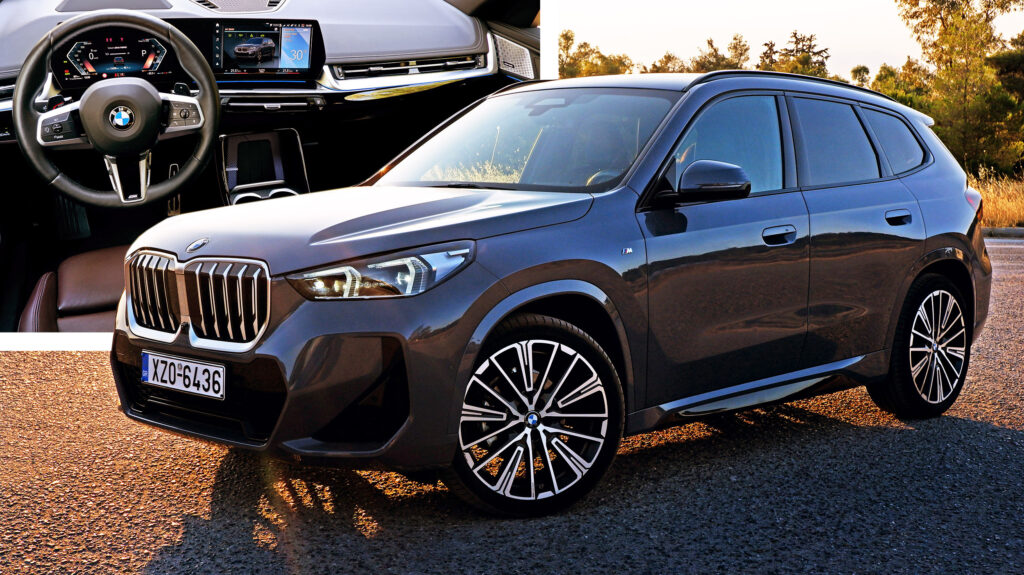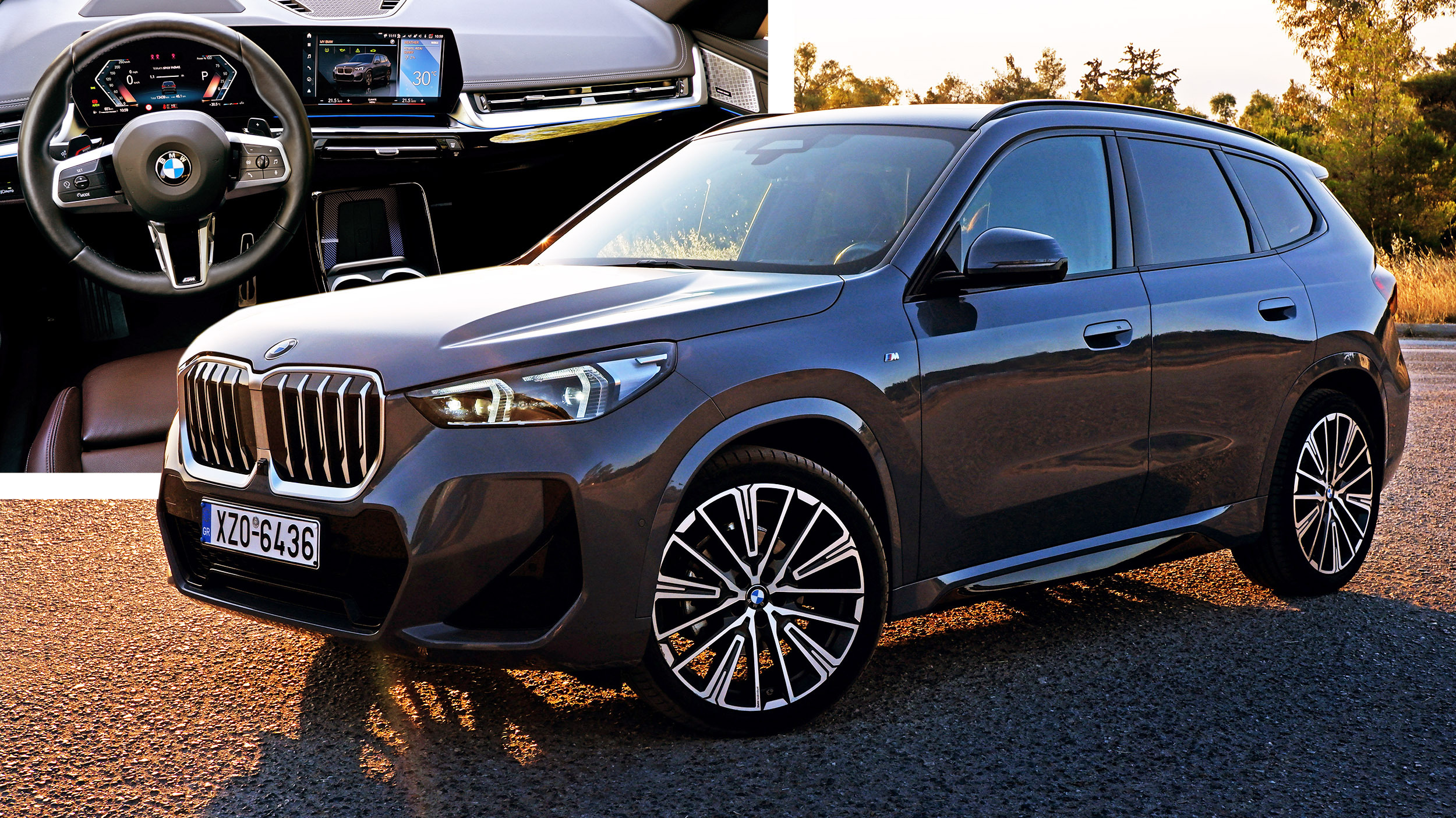Join us as we test the least powerful version of the new BMW X1 in different driving scenarios
July 8, 2023 at 11:58

In its third generation, the BMW X1 has grown into a rather competitive package in the premium compact SUV segment in terms of technology and refinement, offered in petrol, diesel, plug-in hybrid, and fully electric forms. While the flagship X1 M35i sounds like the most exciting version for the automotive enthusiast, we chose to review the entry-level sDrive18i and see how it performs in daily tasks with the least powerful three-cylinder mill.
Despite not being the biggest fan of BMW’s current styling language, I find the X1 one of its most successful applications. The muscular bodywork with angular details communicates the premium essence of the German brand, while the oversized kidney grille is well integrated within the rest of the vehicle. The optional M Sport Pro package of the pictured example certainly adds to the sportiness, especially when combined with the optional 20-inch alloy wheels taken straight from the BMW Individual catalog.
Review: The 2023 BMW X1 xDrive28i Is A Bigger, Better Take On Entry-Level Luxury
Allow me to say that the new X1 looks like it is a quarter of a segment above its direct rivals in the premium compact SUV segment. This is largely due to being one of the newest of the bunch, with the Mercedes GLA being around since 2019, the Audi Q3 since 2018, and the Volvo XC40 since 2017. Also, with a length of 4,500 mm (177.2 inches), it has the second biggest footprint behind the 4,530 mm (178.4 inches) long Alfa Romeo Tonale, inching closer to the first-gen BMW X3. Furthermore, the X1 is the most aerodynamic among its rivals, with a surprisingly low drag coefficient of 0.26 cd.
Class-Leading Perceived Quality And High-Tech Features
Step inside the X1 and you will immediately notice the improvement compared to the previous generation in terms of perceived quality, equipment, and practicality. BMW’s Curved Display combining a 10.25-inch digital instrument cluster and a 10.7-inch infotainment touchscreen works great despite the absence of physical buttons. The climate controls are always at reach on the bottom of the screen, and thanks to the shortcuts of the BMW OS 8.0 everything seems to be a few clicks away. Having said that, I would prefer to have the traditional circular iDrive controller on the center console next to the volume knob, as is the case with larger BMW models.
advertisement scroll to continue
In any case, you can pretty much drive the car without looking at the screens thanks to the well-organized head-up display and the steering wheel controls. In terms of materials, the only downside is the glossy plastic inserts on the dashboard, while the optional Vernasca Mocha leather upholstery of our press car elevates the premium feel.
The cabin feels quite spacious for all passengers, with the rear sliding bench resulting in X3-beating levels of legroom. Furthermore, the optional panoramic sunroof that partly opens contributes to the airy feeling of the interior. Finally, the boot with a double floor and a capacity that ranges between 540 – 1,600 lt (19.1-56.5 cubic feet) in the non-electrified variants is big enough to cover the needs of most families.
Adequate Performance That Doesn’t Exploit The Full Potential Of The Chassis
And now it’s time to talk about what lies under the bonnet and the effect it has on the driving experience. The turbocharged 1.5-liter motor is nothing new for the entry-level BMWs and the entire MINI range. The three-cylinder unit is back in the new generation with a few improvements, despite not getting the 48V mild hybrid system found in the higher-displacement four-cylinder counterparts. The mill produces 134 hp (100 kW / 136 PS) and 230 Nm (170 lb-ft) of torque, which is 4 hp (3 kW) less but 10 Nm (7.4 lb-ft) more compared to its predecessor. Power is exclusively transmitted to the front axle through a 7-speed Steptronic dual-clutch automatic as the manual was axed from the lineup.
Despite my initial expectations, the small engine feels more than adequate for the larger and heavier third-gen X1. It picks up speed nicely on the highway as long as you keep a safe distance from the 208 km/h (129 mph) top speed, and feels zippy when driving in an urban environment. A downside is the lag during start-up caused by the combination of the dual-clutch automatic and the start-stop system. Other than that, the gearbox works fine, with the optional gearshift paddles allowing the driver to take matters into their own hands. There is also a “Boost” function giving you a small power bump when you press and hold the left paddle although I didn’t use it much as the effect is not that noticeable. In terms of fuel consumption, BMW’s official estimates proved to be optimistic, as I saw an average of 9 lt/100km (26 mph) in mixed driving conditions without holding back.
When driving smoothly or cruising on the highway the engine is surprisingly quiet, with the insulation materials doing a great job in muting the characteristic three-cylinder hum. The aerodynamic noise is also low below the 150 km/h (93 mph) mark allowing you to enjoy the great audio quality of the optional Harman Kardon audio system. If you step on the throttle you definitely hear the powertrain a lot more as it tries hard to move the 1,500 kg (3,306 lbs) body, but the revving sound is mostly pleasant. What is not so amusing is the lack of acceleration drama when you seek something more. According to BMW, the sDrive18i completes the 0-100 km/h (0-62 mph) sprint in 9.2 seconds, which is 0.9 seconds slower compared to the 2.0-liter sDrive20i In reality, this is enough for daily driving, but the chassis feels it can handle a lot more power.
The suspension is on the firm side but places the X1 among the best in the segment, improving on the good recipe of the previous generation. When fitted with the M Sport Pro package the suspension is firmer and sits 15mm (0.6 inches) lower, but you can still feel the refinement while benefiting from minimum body roll in the corners. Having said that, comfort is greatly compromised by the 20-inch alloy wheels shod in low-profile run-flat tires, with the smaller options being better suited to the all-rounder character of the vehicle – especially in places with road quality issues.
The steering of the new X1 is noticeably lighter compared to the previous generation, abandoning the heavy setting that is usually associated with BMW and MINI models. While it is still very quick and direct, it doesn’t give much feedback from the road, making it harder to judge the limits of the SUV and prioritizing comfort over sportiness. However, most SUV owners will prefer the ease of use brought by the lighter steering setup.
Finally, I have to mention the exceptional performance of the ADAS systems, including the adaptive cruise control which had a natural and progressive behavior, and the auto parking function which doesn’t require any input from the driver.
What About Pricing?
In Greece, the cheapest BMW X1 sDrive18i with a 1.5-liter engine starts from €39,210 ($42,540) representing a good value overall, when compared with similarly-powered rivals. However, the sDrive20i with the 167 hp (125 kW) 2.0-liter four-cylinder powertrain is only €950 ($1,033) more expensive, making it a no-brainer despite the slightly higher tax and service costs associated with the larger-displacement.
The case is similar in Germany, where the sDrive18i costs €42,800 ($46,608), being €2,100 ($2,287) cheaper than the sDrive20i. Things get more pricey if you want an all-wheel-drive variant with the xDrive system, or if you find yourself looking at BMW’s long list of optional features. Speaking of which, if you tick every single box in the online configurator, you’ll end up with an absurd price of over €70k ($76k) for a base-engined X1, taking it well into X3 territory. As much as we love some of the extras, we would likely spend our money on a more powerful engine instead.
Verdict
Independently of the powertrain choice, the BMW X1 is a well-rounded proposal in the premium compact SUV segment with a commanding road presence and several class-leading characteristics. For those not interested in performance, the entry-level turbocharged 1.5-liter three-cylinder engine in the sDrive18i does a decent job in the majority of real-life scenarios. However, the small price difference with the sDrive20i which gets the 2.0-liter four-cylinder engine makes it hard to ignore, as a more potent powertrain further improves the already compelling driving experience.

stromectol – buy tegretol 400mg for sale order tegretol 200mg
azithromycin 500mg drug – tindamax 300mg without prescription buy nebivolol generic
omnacortil 5mg uk – buy azipro 500mg pills oral prometrium 100mg
gabapentin for sale online – order sporanox pill how to get sporanox without a prescription
furosemide 100mg cost – oral nootropil purchase betamethasone online
order augmentin generic – order nizoral online cheap cymbalta 40mg for sale
buy clavulanate medication – buy generic cymbalta oral duloxetine 20mg
buy tizanidine for sale – buy microzide 25 mg for sale buy generic microzide 25 mg
order sildenafil sale – order tadalafil 5mg sale buy tadalafil pill
order cialis 10mg without prescription – purchase cialis without prescription buy sildenafil 50mg sale
buy cenforce online cheap – buy cenforce cheap generic metformin 500mg
atorvastatin 40mg tablet – generic norvasc 5mg lisinopril 5mg canada
buy prilosec 10mg for sale – buy metoprolol sale tenormin 100mg ca
buy medrol no prescription – depo-medrol pills canada order generic triamcinolone
order clarinex 5mg generic – how to get desloratadine without a prescription priligy order
misoprostol usa – purchase orlistat generic how to buy diltiazem
acyclovir 400mg us – order acyclovir 800mg sale order rosuvastatin pill
domperidone 10mg us – order cyclobenzaprine 15mg generic order cyclobenzaprine
buy warfarin pills for sale – order warfarin 5mg online purchase losartan online
order generic esomeprazole – nexium tablet sumatriptan 50mg brand
order levofloxacin 500mg generic – levofloxacin for sale order ranitidine pill
order meloxicam 15mg generic – oral tamsulosin 0.4mg buy tamsulosin cheap
buy cheap generic ondansetron – zocor 10mg for sale order simvastatin 10mg generic
order valacyclovir 1000mg online – finpecia pills buy forcan tablets